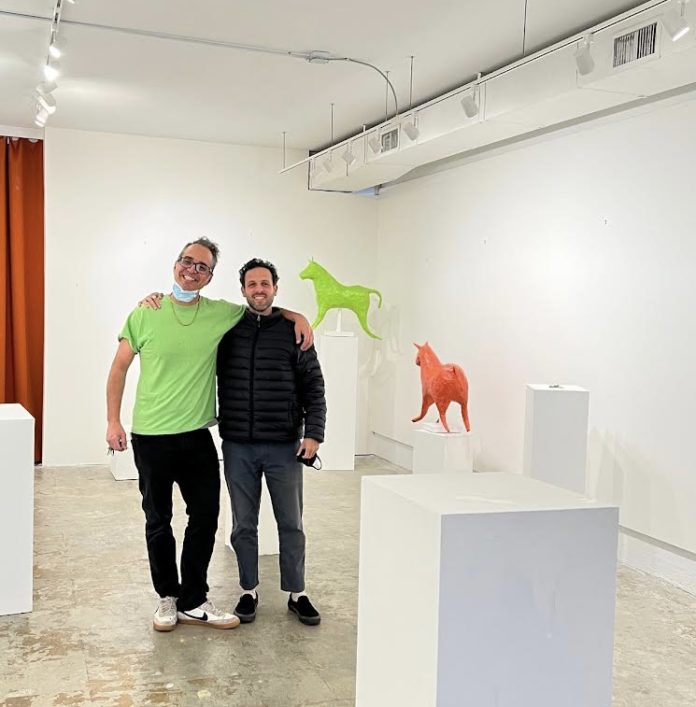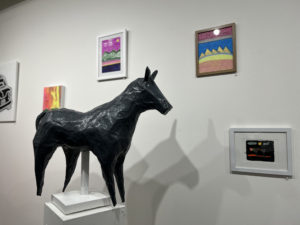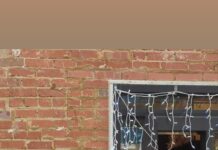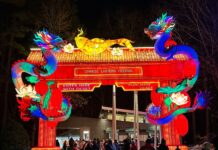
Art teacher Paul Estrada premiered his exhibit “The Earth Makes Us,” a collaboration with artist Saba Jordan featuring papier-mâché sculptures and paintings made with pastel, acrylic and ink, in February at the art space Peel Gallery in Carrboro.
Peel was packed during the exhibit’s premiere with viewers and Estrada’s friends and students, all there to support his work. In the store’s parking lot, Patrick Cudahy, the owner\ of the Carrboro print shop the Merch, performed a DJ set, a mix of 80’s pop oddities and catchy garage rock tunes.
“To me, really, the most important thing is that the community can come together and connect over art,” Estrada said. “It felt great to talk about my own art because I don’t have tons of experience doing that—putting yourself out there in public is really important as an artist.”
Estrada met Jordan while skating at the Chapel Hill Skate Park; after realizing they lived in the same neighborhood, only hundreds of feet away from each other, the pair developed a closer friendship.
“I realized that he lived right next to me a few weeks later when I saw him walking outside of my apartment,” Estrada said. “Before this exhibit, we weren’t just artistic partners—we were just friends who wanted to get back into creating stuff together.”
The coronavirus pandemic, Estrada said, halted his artistic creativity as teaching online was energy-consuming, so when schools and businesses began to re-open in late 2021, Estrada and Jordan promised to get back into creating and discussing art.
To fulfill this promise, the two started a critique group at Peel, meeting weekly to talk about their artistic processes. When an exhibit was suddenly canceled at Peel, owner Lindsey Metivier, whom Estrada and Jordan had befriended, asked the artists if they could create an exhibit to fill the open slot.
“At first, I didn’t think I had work for a show,” Estrada said. “When you put together a show, your work needs a unified feel: I was scared my pieces didn’t have that. But when the time came to open the exhibit, I thought we had a great, pleasing presentation.”
The artists assembled the exhibit in just a few weeks, scrambling to connect their work and fill up the space in the little time they had.
“At first we were not sure how we would approach the show. After coming up with the name ‘The Earth Makes Us,’ we started thinking about how our work could reflect this concept,” Jordan said. “At first, we considered some of my digital work; however, after some consultation, we decided that my original work—plaster, acrylic, mixed media—would convey the more natural look we were going for.”
Estrada’s pieces in the exhibit included multiple papier-mâché sculptures, large heads and horse-like animals that Estrada used to focus on natural shapes and anatomy.
The sculptures originated in 2019 for an art residency where Estrada filled parts of an empty storefront on Franklin Street with his art. The exhibit was in collaboration with UNC-Chapel Hill, the Orange County Arts Commission and Downtown Chapel Hill.
“The space and money were given to artists in the area to put an exhibit together,” Estrada said. “Doing that exhibit really helped me get distinctly back into art because I’m into music, skateboarding and art: it’s easy to get sidetracked.”

Despite making both realistic and minimalistic horse sculptures, Estrada included only the latter in the “Earth Makes Us” exhibit because their vivid colors and simplistic geometry better matched Jordan’s art style.
“I was just thinking about geometric forms of humans and animals in a simple manner,” Estrada said. “I did a lot of realistic sculptures of horses before that didn’t really go with Saba’s work, so they didn’t make it into the exhibit. I wanted to make the sculptures playful and not perfect—I made nine of them in a month, so they’re kind of a product of my process.”
Estrada also provided two black-and-white paintings to the exhibit, featuring different angles of classic American cars, the ones his parents drove him in as a child. The paintings are more detailed components of a larger landscape piece he made, which represents an interpretation of his parents meeting for the first time. Estrada wanted to focus on a specific aspect of the piece’s sprawling scenery instead of adding to the already cluttered frame of the original painting.
Jordan’s contributions included small pastel landscapes that acted like windows into vividly colored worlds. Some pieces focused more on the textural qualities of paint, as splatters and wads of it covered canvases, while others focused more on applying disorienting colors to familiar scenery: two-dimensional, triangular mountain ranges were colored bright green with the skies above them a deep purple. With his pieces, Jordan analyzes how humans retain a connection with nature as a hyper-digital culture continues to develop.
“My process is very instinctual and I love using color to convey emotion and a connection to nature,” Jordan said. “Although my inspiration is greatly drawn from nature, I believe art is very personal and one of the most exciting things about it is how different people can have such unique experiences.”
Connecting his pieces with Jordan’s, Estrada said, was a seamless process. The pair’s friendship eased the difficulty of creating an exhibit together.
“Saba had a bunch of artwork that I worked around, adding what I thought would fit,” Estrada said. “I just wanted to match what Saba had going on.”
Anyone unable to visit the exhibit has another chance to see Estrada’s art in late April, as he was commissioned by UNC-Chapel Hill to create giant bird sculptures for the university’s new Center for Galapagos Studies.











